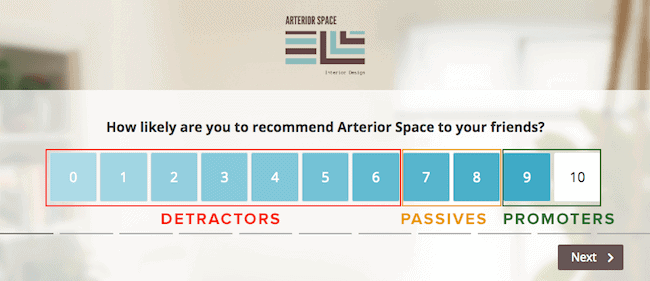If your company has implemented strategies to measure customer satisfaction and loyalty, you’ve almost certainly heard of the Net Promoter Score (NPS). This method is well-known as a practical way to predict revenue and profit growth.
In fact, research shows a correlation between high NPS scores and greater customer loyalty, leading to an increase in revenues and profits.
Of course, boosting your company’s results is more complicated than simply increasing your Net Promoter Score — nonetheless, keep reading to find out how this valuable strategy can help you achieve your goals.
Net Promoter Score: Are your customers promoters, passives or detractors?
To find out what category a customer falls into, simply ask them the following question:
“What is the likelihood that you would recommend [Company X] to a friend or colleague?”
The answer is usually given in the form of a number, often on a scale of 0 (not at all likely) to 10 (very likely). Depending on the customer’s score, they are placed into one of 3 categories: Promoters, Passives or Detractors.

A score of 9 or 10: Promoters
Promoters show the most loyalty and enthusiasm towards your company, and will continue to buy your products while recommending your company to friends and family. To be considered a promoter, customers must provide a very high rating (a minimum of 9). This ensures that the category represents your company’s most enthusiastic fans.

Promoters can play a significant role in your marketing strategy. As the name suggests, this category of customers represents a significant opportunity to promote your brand. With the right assistance, they can truly become excellent brand ambassadors.
Read our article: NPS, the Good, the Bad and the Ugly.
A score of 7 or 8: Passives
Passives are usually satisfied customers, but they do not show the same level of enthusiasm towards your company as those in the “promoters” category. Of course, a score of 7 or 8 is impressive, but research has shown that customers in this category are susceptible to being swayed by competitors’ offerings.

A score from 0 to 6: Detractors
Detractors are often customers who have felt unhappy or disappointed with the company, and may therefore have a negative impact on your brand. If a client has given your company a score between 0 and 6, it is essential to proactively communicate with them, working towards resolving the problem before these negative effects become more significant.

Discover The hidden value of customer criticism.
How do I calculate the Net Promoter Score?
Once you have determined which categories your clients fall into, you can calculate your company’s NPS score by subtracting the percentage of detractors from the percentage of promoters.
The score is generally displayed as a whole number. Here’s an image showing the calculation method:
Net Promoter Score = % Promoters – % Detractors
The Net Promoter score is between -100 and 100.
Why is it important to have a high Net Promoter Score?
The Net Promoter Score, developed by Fred Reichheld, is a way of measuring customer loyalty. This strategy was initially designed to show how customers would portray a company to their friends, families and colleagues. Reichheld maintains that a company’s results are strongly linked to their future growth.
Research by Bain Company shows that companies who achieve sustainable, profitable growth have NPS scores that are two times higher than the average. Apple, Amazon and Zappos are often cited as examples.
The Net Promoter Score, an indicator of customer satisfaction or brand recognition?
It is often challenging for companies to steer all of their departments towards a customer-centric approach. Proponents of this measurement tool state that the Net Promoter Score is aimed at evaluating customer satisfaction, and that the easy-to-understand method encourages the entire company to implement and maintain customer-focused strategies.
Though the NPS does not provide detailed information about customers, the simplicity of this system allows companies to quickly and effectively implement these strategies.
Critics of the NPS state that this tool shows a customer’s attitude and intention to recommend the brand, rather than their actual behaviour, and that the Net Promoter Score does not provide sales indicators or information about future growth, such as product innovation or changes to pricing strategies.

The Net Promoter Score is simply a way of measuring quality and customer satisfaction, rather than brand recognition, brand equity or market power.
The Net Promoter Score, primarily a way for customers to share their opinions
The most important thing to keep in mind is that customers have more opportunities than ever to share their opinions. These opinions can, of course, either benefit or hurt your brand. The NPS is a strategy that enables companies to measure customer loyalty, and is often used successfully by many companies who are looking to gain insight on customer satisfaction.
Whether your company uses the NPS or another method of measuring customer loyalty or satisfaction, the goal is the same: determine the most effective ways to improve the customer experience.



















